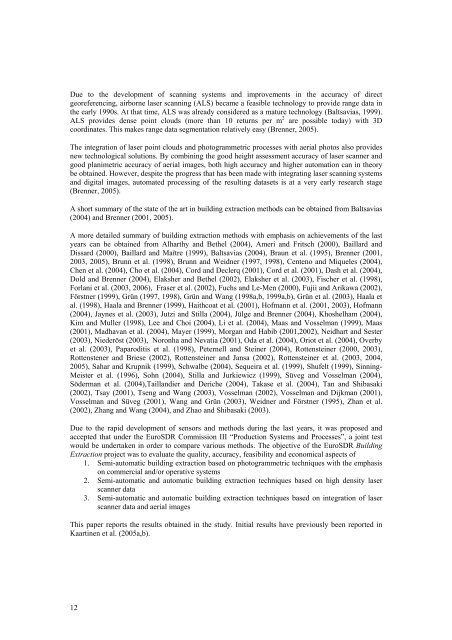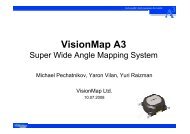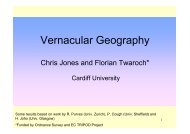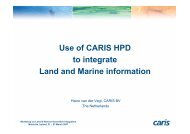EuroSDR Projects - Host Ireland
EuroSDR Projects - Host Ireland
EuroSDR Projects - Host Ireland
Create successful ePaper yourself
Turn your PDF publications into a flip-book with our unique Google optimized e-Paper software.
Due to the development of scanning systems and improvements in the accuracy of direct<br />
georeferencing, airborne laser scanning (ALS) became a feasible technology to provide range data in<br />
the early 1990s. At that time, ALS was already considered as a mature technology (Baltsavias, 1999).<br />
ALS provides dense point clouds (more than 10 returns per m 2 are possible today) with 3D<br />
coordinates. This makes range data segmentation relatively easy (Brenner, 2005).<br />
The integration of laser point clouds and photogrammetric processes with aerial photos also provides<br />
new technological solutions. By combining the good height assessment accuracy of laser scanner and<br />
good planimetric accuracy of aerial images, both high accuracy and higher automation can in theory<br />
be obtained. However, despite the progress that has been made with integrating laser scanning systems<br />
and digital images, automated processing of the resulting datasets is at a very early research stage<br />
(Brenner, 2005).<br />
A short summary of the state of the art in building extraction methods can be obtained from Baltsavias<br />
(2004) and Brenner (2001, 2005).<br />
A more detailed summary of building extraction methods with emphasis on achievements of the last<br />
years can be obtained from Alharthy and Bethel (2004), Ameri and Fritsch (2000), Baillard and<br />
Dissard (2000), Baillard and Maïtre (1999), Baltsavias (2004), Braun et al. (1995), Brenner (2001,<br />
2003, 2005), Brunn et al. (1998), Brunn and Weidner (1997, 1998), Centeno and Miqueles (2004),<br />
Chen et al. (2004), Cho et al. (2004), Cord and Declerq (2001), Cord et al. (2001), Dash et al. (2004),<br />
Dold and Brenner (2004), Elaksher and Bethel (2002), Elaksher et al. (2003), Fischer et al. (1998),<br />
Forlani et al. (2003, 2006), Fraser et al. (2002), Fuchs and Le-Men (2000), Fujii and Arikawa (2002),<br />
Förstner (1999), Grün (1997, 1998), Grün and Wang (1998a,b, 1999a,b), Grün et al. (2003), Haala et<br />
al. (1998), Haala and Brenner (1999), Haithcoat et al. (2001), Hofmann et al. (2001, 2003), Hofmann<br />
(2004), Jaynes et al. (2003), Jutzi and Stilla (2004), Jülge and Brenner (2004), Khoshelham (2004),<br />
Kim and Muller (1998), Lee and Choi (2004), Li et al. (2004), Maas and Vosselman (1999), Maas<br />
(2001), Madhavan et al. (2004), Mayer (1999), Morgan and Habib (2001,2002), Neidhart and Sester<br />
(2003), Niederöst (2003), Noronha and Nevatia (2001), Oda et al. (2004), Oriot et al. (2004), Overby<br />
et al. (2003), Paparoditis et al. (1998), Peternell and Steiner (2004), Rottensteiner (2000, 2003),<br />
Rottenstener and Briese (2002), Rottensteiner and Jansa (2002), Rottensteiner et al. (2003, 2004,<br />
2005), Sahar and Krupnik (1999), Schwalbe (2004), Sequeira et al. (1999), Shufelt (1999), Sinning-<br />
Meister et al. (1996), Sohn (2004), Stilla and Jurkiewicz (1999), Süveg and Vosselman (2004),<br />
Söderman et al. (2004),Taillandier and Deriche (2004), Takase et al. (2004), Tan and Shibasaki<br />
(2002), Tsay (2001), Tseng and Wang (2003), Vosselman (2002), Vosselman and Dijkman (2001),<br />
Vosselman and Süveg (2001), Wang and Grün (2003), Weidner and Förstner (1995), Zhan et al.<br />
(2002), Zhang and Wang (2004), and Zhao and Shibasaki (2003).<br />
Due to the rapid development of sensors and methods during the last years, it was proposed and<br />
accepted that under the <strong>EuroSDR</strong> Commission III “Production Systems and Processes”, a joint test<br />
would be undertaken in order to compare various methods. The objective of the <strong>EuroSDR</strong> Building<br />
Extraction project was to evaluate the quality, accuracy, feasibility and economical aspects of<br />
1. Semi-automatic building extraction based on photogrammetric techniques with the emphasis<br />
on commercial and/or operative systems<br />
2. Semi-automatic and automatic building extraction techniques based on high density laser<br />
scanner data<br />
3. Semi-automatic and automatic building extraction techniques based on integration of laser<br />
scanner data and aerial images<br />
This paper reports the results obtained in the study. Initial results have previously been reported in<br />
Kaartinen et al. (2005a,b).<br />
12









